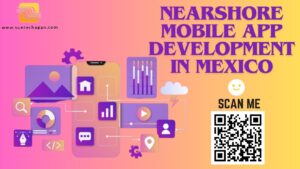What Does It Cost to Make an App?
8 min read
Untitled design
What does it cost to make an app? Software development companies are often asked this question. You should know where your money goes when creating your mobile solution. This guide explains everything you need to know about mobile app development costs.

The factors that influence the cost of app development
There are several things that significantly affect typical app development cost:
- Features and functionality
- App types, platforms, and devices
- Backend infrastructure and admin functionality
- Design

Functionality and features –
An application’s features are what make it unique. This is one of the most important parts of custom app development. Well-chosen features will resonate with users and encourage them to come back to your app. The secret behind what makes features so valuable is how they improve the value of your application. The first thing you should do when creating an app to help users connect is to think about how the app will help people connect, like real-time chat, smart search, file sharing, and personal profiles.
Each app should offer these features. Additional features can encourage user engagement, but they aren’t required at first.
Features that are a must –
Our team has prepared a list of questions you should answer to discover how many hours it will take to build your must-have features.
Do users need to log in?
To access certain features on some platforms, users need to log in. Other platforms allow users to access certain features without logging in. A login feature is best for applications that enable private messaging, chats, and loyalty cards. The best practice for login is to support email login as well as social login using Facebook, Google+, or Twitter.

Are users required to create a personal profile?
Once a user has logged in, it is common for them to create a profile. Facebook and other social networks can pull information from some applications, creating a personal profile automatically. As far as personal profiles go, you have two types. A simple and a complex
The simple profile 一 User name, short bio, and profile picture.

The complex profile 一 Information about users’ interests, skills, education, and more. The platform can also give data on the number of followers and recent activity.

Is it necessary to integrate a payment system into your app?
Your app doesn’t need a payment gateway if it’s free to download. In the event that you’re going to take a commission from sellers (for example, in eCommerce apps), you should integrate an online payment system into your application.
There are many payment gateways available. Your choice of payment method depends on your target market. Paypal holds almost a 56% market share, and 457 thousand companies use it, according to Datanyze. Another leading payment gateway is Stripe, which accounts for 17.2% of global payment solutions. There are also a few other popular payment gateways that you might want to consider, including Amazon Pay (3.9%), Braintree (2.2%), Stripe Checkout (2%), and Square (1.9%).
The time necessary to integrate mobile payments varies greatly, depending on different factors. This includes:
- Complexity of the functionality
- Frontend vs backend workload: who’s responsible for what and how much work needs to be done by whom
- Quality of a payment gateway’s documentation
- Presence/absence of a reliable SDK/libraries
- Ability to use sandbox for testing a payment processor
- Technical support response time
How important is it for your application to allow users to rate businesses and leave feedback?
Through feedback and ratings, you can control quality and build trust on a platform. Customers can use this feature to make informed decisions when choosing producers and service providers. In some applications, users and producers can rate each other after a service or good has been delivered. For example, Uber asks both riders and drivers to rate their experiences after a trip. As part of Airbnb, travelers are expected to leave feedback for hosts, and hosts are expected to leave feedback about how well guests followed the rules, left the accommodations clean, and communicated their needs.
What about social integration? And how will you drive user engagement?
To increase user engagement in your app, you can build handy features such as messaging, forums, and social sharing. Have a look at how much time it takes for a Suntech Applications to implement these features.

Additional features :
Push notifications help you keep in touch with users. Notifications provide essential information such as updates, offers, changes, and alerts. Anything you want users to be aware of can be delivered via push notifications.
Geolocation helps users find your store, and not just that, but also the best deals in their area. The development of geolocation is perhaps one of the most important advantages for both developers and business owners which should be heavily considered when planning mobile application development.
A calendar is an ideal option to base your travel, planning, doctor’s appointment, and many other apps. Not only can one display upcoming events better than any of the most popular existing daily planners , but calendars are also able to sync with existing separately produced apps that require a remote backend server.
Online booking can be useful feature for any business that offers on-demand services in the following categories: transport, accommodation, food and beverage, or home services. The idea is to give software users an option of ordering and booking right inside their app or mobile website.
Audio and video functionality is a good option for social media apps, allowing users to send video or audio messages and share media files.
News feeds provide users with a constant flow of content — news, articles, pictures, or anything else that’s important for your industry 一 to drive user engagement and retention
Tags will help you organize your app and assist you with making faster and more enterprise-level changes by way of search.
A search engine works to match users with content. When there is a successful match and the user uses the content, they become more likely to regularly participate on the platform and be drawn back in again and again. If you want users to return to your app you should ensure that search results are always relevant. A key to achieving this is by creating an enjoyable experience for your users such as providing them with answers or matching them with content before they even ask the question! Remember, if you’re not prompting your audience they may never know what you have to offer (or find any value) so, if push notifications are appropriate for your product, we suggest sending them frequently.
App types, platforms, and devices
App startup costs also depend on the type of application and the number of platforms you’re building it for.
What type of an app are you building?
Mobile applications generally fall into one of two types: native apps or cross-platform apps. The right type depends on what you want to use it for.
- Native applications are built for a specific operating system: Android or iOS. These apps boast the highest performance and benefit from access to hardware like GPS sensors, cameras, microphones, touchscreen, and more. They’re best for complex projects full of functionality and ever-changing features.
- Cross-platform applications function on both iOS and Android. They’re best for projects that don’t need to support complex features and platform-specific functionality.
How to decide between Android and iOS –
If you’ve decided to build a native application, you need to choose the right platform to build it for 一 Android, iOS, or both. Your target audience will give you a clear picture of which platform is better for you.
While Android dominates the market, some successful apps like Instagram and Periscope came out first on iOS. Why do companies choose to launch iOS apps first? There are many possible answers to this question, but we’re convinced that iOS users spend more money on apps than Android users. Many businesses think they can recoup their investments faster with iOS development. This might not be the case for your app. People prefer different operating systems in different countries. Germans, for example, prefer Android-powered smartphones, which account for 68% of the market. 56% of Australians prefer iOS over Android. Furthermore, building an iOS app is a less time-consuming and less demanding process. Thus, many companies find the iOS app development cost more attractive than the Android app development cost.Apps for iOS and Android are often developed simultaneously by most companies. Apps like Twitter, Airbnb, Uber, Instagram, Snapchat, and dozens more are available for both Android and iOS.
Backend infrastructure and administration –
In most cases, applications need a backend with APIs that allow them to share data with a database. Typically, the backend generates, processes, stores, and modifies data.
These are some admin options that can be useful for managing the content of an app:
- Admin page for users – Manage users by adding, removing, suspending, or restoring them.
- Content moderation – Allows admins to approve or reject content before it is published.
- Analytics for users – Get insights into how users behave on your platform by tracking their activities.The best analytics tools are Google Analytics, Clicky, and Kissmetrics
- Error reporting – Discover errors and crashes that affect the user experience.
- Application performance monitoring — Troubleshoot problems regarding app performance and get performance metrics to find the root of the issue.
- Multilingual support — Offer your app in various languages to achieve a larger audience.
Extra costs of developing an application :
In addition to expenses of app development and design, there are other things you’ll have to pay for.
A marketing strategy
When there are over two million apps on the market, how will people find your app? Marketing is the key! Today, advertising is just as important as the product itself. To effectively market your app, you must speak to your target audience so they will become interested in it. Your product can be promoted through social media, paid advertisements, app marketing agencies, and other channels.
Service and maintenance
The development of an application isn’t a one-time task. To remain competitive, your app needs to be constantly updated. It’s not just about updating your application; it’s about fixing bugs, adding new features, providing security updates, and upgrading with new operating system releases. This all costs money.
Hosting fees
In order to store data in the cloud, you will need to pay for your hosting server. Hosting costs vary based on how much data you need to store and the provider’s price.
A third-party tool
Most companies use third-party solutions like Twilio, Google Analytics, and Crashlytics to implement functionality such as online payments, messaging, analytics, and testing Some third-party solutions like Mixpanel and Woopra offer free trials; others don’t charge unless you use them beyond a certain point. You can use Google Analytics at no charge for up to ten million hits a month.
Our guide on ” What Does It Cost to Make an App ” Should have given you a better understanding of what determines app development costs. Contact Suntech Application if you have any questions or would like a free consultation.








